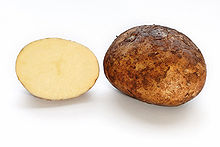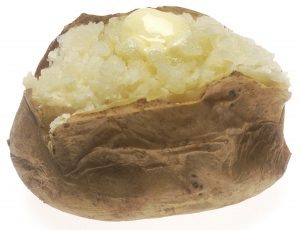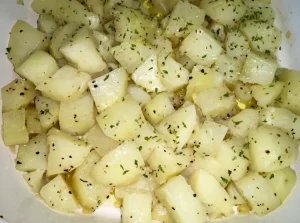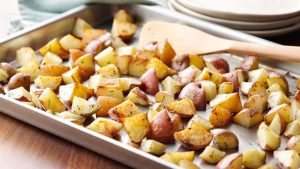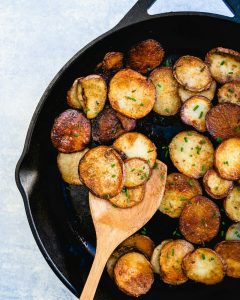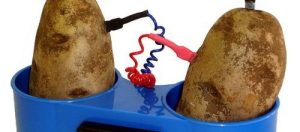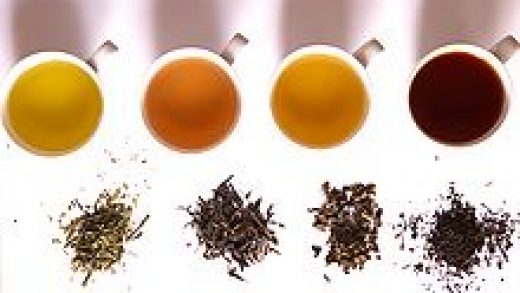Sometimes when I’m writing, I suddenly look up and notice that something has gone on way too long. That happened when I was writing a post about cooking potatoes. I had barely tackled the subject when I noticed it was running long. So, I’m continuing that post here. Okay, I’m long-winded.
As a reminder, we’re talking about eating more vegetables and learning about all the many ways they can be cooked and prepared. Potatoes are a common vegetable that lends itself to many, many different ways of preparation. We’re talking about some of the leading ways in hopes it will spark your creativity the next time you’re fixing potatoes for a meal.
We’ve covered boiling, steaming, and mashing. So, let’s look at some more cooking styles.
Simmer or braise: This is not a common technique for potatoes, but it might be one worth trying. Cut potatoes into 1/2-inch pieces and add to a large, cold skillet. Stir in 1/2 cup of broth, 1/2 cup milk, and a teaspoon of butter. Over medium heat, bring to a simmer, then cover and lower the heat. Cook for about 20 minutes or until nearly all the liquid is absorbed.
Baked: The good thing about this method is that it adds little or no additional fat, which makes it a more healthy way to prepare potatoes. Russets work best. There are many ways to do this, but I’ll tell you my favorite. Scrub the potatoes well, I like to eat the skin. Preheat the oven to 450ºF. On a square of foil, coat the potato with extra virgin olive oil and a sprinkling of kosher salt. Wrap the potato completely and bake for about an hour. You can speed up the process by putting the potatoes unwrapped into the microwave for about 4 minutes. I don’t like to completely bake potatoes in the microwave because I find the ends get hard.
Microwave: Potatoes are one of the best vegetables for this method. You can bake a whole potato this way, but as I just said, I don’t think it works that well. But they can be roasted in the microwave wonderfully. My favorite way is to cut the potato into 1/2-inch chunks and coat it with olive oil, salt, pepper, paprika, chili powder, garlic powder, and dried parsley. This goes into a plastic dish that’s mostly covered (allow steam to escape) and microwave on high for three minutes, stir and cook for at least another 2 minutes.
Roasting: If you’re not in a hurry, you can use the same preparation outlined above for roasting in an oven. It should be preheated to a temperature of 450 to 500. The potato pieces should be laid out in a single layer after being coated in oil, herbs, and spices. About 20 to 25 minutes should give you potatoes with a crispy outside and a fluffy inside.
Frying: There are a number of different frying styles you can use. French fries are usually deep-fried. Slices or small chunks fried are called home fries. Sliced thin and fried give you potato chips. Shredded gives you hash browns. Shredded, squeezed, and formed into patties gives you latkas or potato pancakes.
International Flavor: In South America where the potato originated, it’s used largely as an ingredient in a variety of dishes. One of the most interesting versions uses cooked, diced potatoes as part of a filling for chili rellena, a sort of stuffed pepper. It’s also a common ingredient in many soups and stews, including Ecuadorian locro de papas, made with potatoes, squash, and cheese. There are many British dishes that feature potatoes: fish and chips, shepherd’s pie, bubble and squeak, and bangers and mash. Boxty pancakes are found throughout Ireland and Irish communities in the U.K. They are made with grated potatoes which have been soaked to release the starch and then combined with flour, buttermilk, and baking powder. In Eastern Europe, grated potatoes are made into puddings like kugel or bobka. Italians make a potato dumpling pasta called gnocchi. Fried potatoes in a spicy tomato sauce is a common Spanish tapas dish. In Canada, they have a dish called poutine, french fries topped with fresh cheese curds and gravy.
All of these only touch the surface of how potatoes can be cooked. But that’s not all. Other uses for potatoes are to make art, including pottery; to make liquor, like vodka or potcheen; and as animal feed. Potato starch is a common industrial food additive used to thicken and bind soups and sauces. Some potatoes are used to make adhesives. And just lately, scientists are using potatoes to make plastic and biodegradable packaging. Many young students have made a potato battery.
I’m sure with all this, you can find plenty of ways to make potatoes a part of your eating plan without getting bored.
